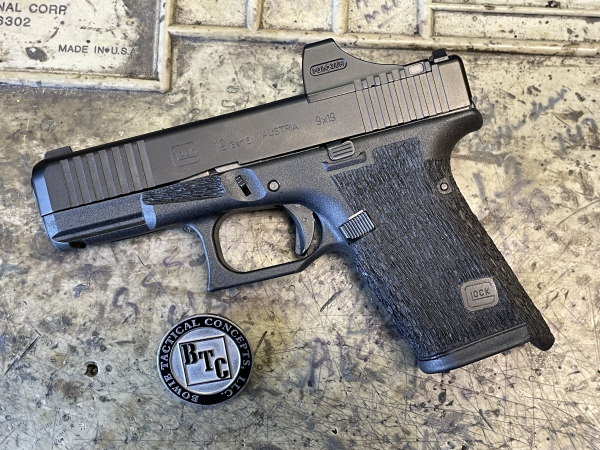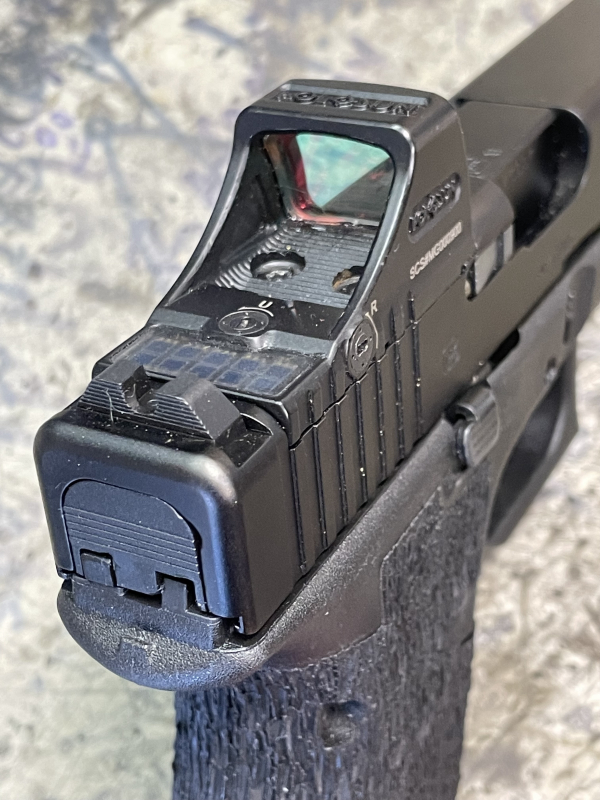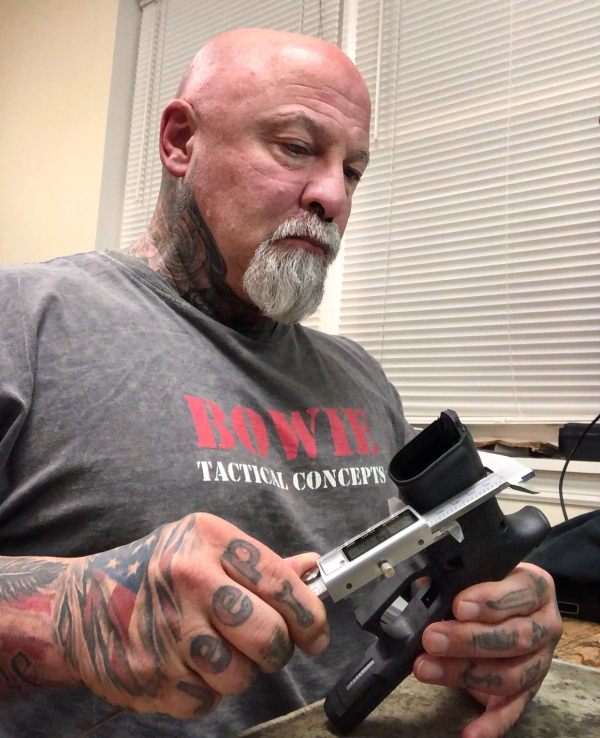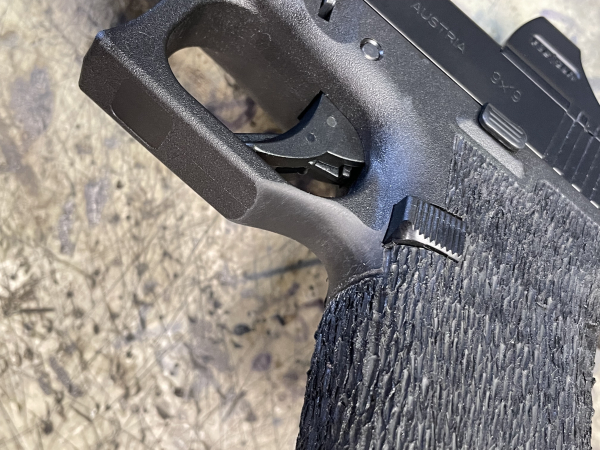Today’s feature is from correspondent Dave Spaulding.
en·hance: /in?hans,en?hans/ verb: intensify, increase, or further improve the quality, value, or extent of.
During the late unpleasantness (COVID lock down), I started building “Gucci Glocks” for something to do. Initially, components were easy to get and I had a good time doing it. I tried different slides, frames, triggers and other parts and along the way and learned a lot about the Glock operating system. I built ten different guns, selling most but gifting a few and even thought I might like to do it as a business. Fortunately, I came to my senses and got over that thought.
The biggest lesson I learned is that the Glock really needs (“want” is a different thing) very few modifications. I also learned that with the wide availability of after-market parts, the best performing components come from Glock. I know some will disagree with me. There are a few after-market parts I use, like the Vickers slide lock lever, but it’s because Glock does not make the part the way I want it.

Until recently, I was a devoted “Third-Generation” fan. This was mostly due to familiarity, but when folks like Ken Hackathorn, Bob Radecki, Bucky Buchanan and the U.S. Secret Service tell me I really needed to look at the Fifth-Generation guns, I take notice. Once I bought one and put it through its paces, I too concluded that the Fifth Gen. GLOCK was the way to go. The MOS version with its slide cut for the addition of carry optics was a no-brainer.
On my pistol, the trigger was pretty good right from the box. After 400 rounds, however, I thought I could make it better. I added a Glock factory 3.5 connector and polished all the metal-to-metal engagement surfaces. Yes, I know that I can shoot it smooth, but ammo is expensive, so I chose to hasten the process. I clearly remember my 8th grade metal shop teacher saying, “where metal meets metal, polish and lubricate!” It worked then and it works now. Polished metal will make for a smoother surface, allowing parts to better “glide” past one another. Do not round the edges! Keep the engagement surfaces sharp so they work as designed. Using factory springs, my trigger broke at 4.5 pounds. A heavier striker spring would likely get it over 5.
As I have stated in previous WIRE articles, I have “gone over to the dot side.” When I started thinking about which optic to use, it made sense to go with the one that would fit the factory cut perfectly since I don’t like mounting plates. They create too many problems. The Holosun SCS MOS offers a low profile which permits standard height sights to be used with the optic. Being the same width as the Glock slide, the SCS is easy to carry and conceal. Some may worry the smaller window will make finding the dot more difficult, however, good biomechanics and presentation will solve this problem.

I was initially concerned the green dot would not glow brightly enough in bright light, but this turned out not to be the case. I pointed the optic towards the sun and, if I did not place it directly in line, the green dot was visible. The SCS has an auto brightness feature which some will not like, but I did not find it to be a problem. If could see it - which I could across all light spectrums I tested it in - it was good enough.
The concept of “optimum brightness” is problematic. I have seen students stop in the middle of a drill to push the brightness buttons on their optic to get the “optimum” glow…would you do this in a fight? I never had a set of irons, tritium or otherwise, that gave me an optimal glow -- why would I expect it of a dot optic? If you can see the dot, place it where you need it and depress the trigger. NEVER stop in the middle of a confrontation (or during training, for that matter) to mess with buttons.
The SCS has a solar charging window at the rear that uses sunlight to keep it powered so no changing batteries. In my mind, it’s one less thing to deal with. Will it hold up over a long period? Only time will tell, but Holosun has a high success rate with pistol optics, so I am willing to give them the benefit of the doubt. The SCS has a Titanium body, so it should be able to stand up to routine EDC duties. I will let others torture test it. My big concern is unexpected loss of zero, not dropping it upside down.
As hard as I tried, I could not get used to the 5th Gen. grip angle. While the tang to trigger reach has been improved, the “hump” at the bottom of the back strap threw off my ability to naturally point the pistol. Over the years, what I have found a front strap and back strap that are parallel, much like a 1911 with a flat mainspring housing, works best for me. If I could modify the 5th Gen. to an angle like this, I would have this neat little pistol right where I want it. Enter David Bowie of Bowie Tactical Concepts.

I have known David for over 25 years, first meeting him when I was a student at the Tactical Defense Institute and then working with him when I was an instructor there. David is a former crime scene photographer, Prosecutor’s Investigator, SWAT Team Commander, and still active Deputy Sheriff, so he has a few thoughts on what should go into a combat pistol. His modifications are HIGHLY regarded in combative pistolcraft circles and he has become known as the “go to guy” to repair the “mistakes” of other custom gunsmiths.
David was able to take my 5th Gen frame and cut it down so the front and back straps were parallel while also reducing the circumference a bit. He then applied a stippling patten I call “sandpaper-like,” which really grips my hand without being too abrasive. My hands sweat, even in colder weather so I really appreciate this surface. He also undercut the rear of the trigger guard to eliminate “GLOCK knuckle” and get my hand as close to the bore line as possible. He also placed a thumb ledge on the left side of the frame. I use this ledge not to try and control recoil as some claim, but to ensure a consistent grip, which is essential for consistent recoil control.

I do not view a modified grip as something that will cause me liability issues. It is an enhancement that allows me to shoot the gun to a higher level. In the revolver days, changing the grip was typical, so having my Glock grip modified to make it better fit my hand makes sense.
A trip to the range proved that I had made the right choices. I zero my optics, off hand, at ten yards on a 3-inch square and then reconfirm at 25 on a 3 x 5 rectangle. The SCS MOS required no zeroing; it was right on from the first shot. Holster work proved that the grip angle was much more to my liking with the gun naturally arriving on target. The definition of a good combat draw is the gun arrives where you need it. Establishing a grip angle to enhance this process is worth the effort. Whether at distance or up close and fast, the Holosun SCS MOS proved to be quick and easy to use with the green dot standing out.
Enhancements are those modifications that make a tool better perform for the end user. Whether its grip tape on a hammer or changing the grip angle on my pistol, it’s about increased performance. If I were to be asked for my opinion about a “6th Gen. GLOCK” it would look like this, perfection in my eyes.
Dave Spaulding is a professional firearms instructor with 36 years' experience in law enforcement and federal security. The recipient of the 2010 Law Enforcement Trainer of the Year Award from the International Law Enforcement Training and Educators Association, Dave has worked in all facets of law enforcement including communications, corrections, court security, patrol, evidence collection, training and investigations. He was a founding member of his agency’s SWAT Team and acted as its training officer for 8 years. He spent a year in an undercover capacity and was the commander of a multi-jurisdictional narcotics task force, has been an adjunct instructor at the former Heckler & Koch International Training Division and the Tactical Defense Institute. In addition to his many published articles (over 1,400), Dave is the author of two acclaimed books, Defensive Living and Handgun Combatives. He operated his own training company with focus on “the combative application of the handgun” www.handguncombatives.com.
